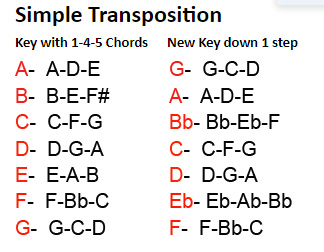Transposing to a Lower Key

I recently saw a question on Quora which was basically asking “If a song is in a key too high for me to sing, how do I adjust my chords so I can hit the high notes? Should I just tune my guitar strings down a tone or semi-tone?”
Many people responded to this question by saying: “Get a capo. That’s what a capo is for.”
But this doesn’t really solve the problem? Until we hear how exactly we are supposed to use a capo to solve this problem, the problem remains unsolved. If a song is currently being played in, say, G, putting a capo on the first or second fret will just raise the pitch…making the problem even worse.
What you need to do is pitch the song lower, and this will involve using different chords. To solve the problem with a capo (using the same chord shapes) you would have to play the song way up the neck. So, while a capo might help, you will still have to do some transposing.
The solution is to use different chord shapes, ie., transpose the song to a different key. For example, if the original song is pitched in G and calls for G, C and D chords, to pitch the song a full step (tone) lower you would have to play it in F with chords F, Bb and C (each a full step below the original chord).
If you don’t want to play in F you could put a capo on fret 1 and play as if you are in E (E raised a half step is F). The chords you now need are E, A and B. Transposing is not that difficult. You just have to think it through.
Here’s a suggested procedure:
Step 1. Write down the chord sequence. Don’t try to do it “in your head”.
Step 2. Now write down the revised chords for the new key. If you are transposing down 1 step G, C and D down 1 full tone would be F, Bb and C. If transposing down down 2 steps the new chords would be Eb, Ab and Bb. If you are transposing up one full step the new chords would be A, D and E (or just put a capo on fret 2 and play as if in G).
The important thing is to think in terms of chords rather than get hung up on keys, sharps and/or flats. Of course it is important to know the chromatic scale so you know the intervals between notes. For example, it is important to know that C is a full step below D, but B is only a half step below C.




In the chart A is not a full step below Bb. Chords for B would be B, E and F#. Down 1 step from Bb would be Ab, Db and Eb.
Fixed